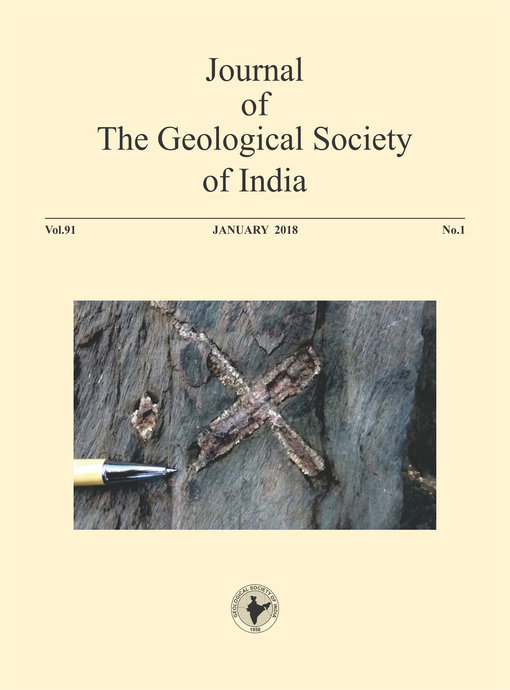Hydrothermal Fracture Controlled Vein Type Uranium Mineralization in the Paleoproterozoic Bijawar Group of Rocks, Sonrai Basin, Lalitpur District, U.P. – Fresh Findings from Subsurface Borehole Data
DOI:
https://doi.org/10.1007/s12594-018-0816-yAbstract
Sonrai basin, located along the southwestern margin of Bundelkhand Granite-Gneiss Complex (BGC) is known for its base metal and phosphorite mineralization. Uranium mineralization of appreciable grade and thickness was reported in Pisnari block in the northern part of this basin during sub-surface exploration activity in 1976-97. This was in the form of uranium-bitumin association within fractures in the carbonate-terrigenous sediments of Gorakalan shale, Rohini carbonate and Bandai sandstone of Sonrai Formation of Bijawar Group. Similar mineralization was also noted within the lower chloritic shale member of Solda Formation of the same Group. During subsequent drilling activity at a later phase (2005-09), uranium rich zones within Rohini carbonate and chloritic shale members were corroborated by the interception of mineralized bands in two boreholes drilled near Pisnari. Petrographic study of radioactive core samples reveal that uranium mineralization is closely associated with globular carbonaceous matter and sulphides along the fractures. Uranium is either adsorbed in carbonaceous matter or occurs as ultrafine inclusions of coffinite within carbonaceous matter. An additional phase of secondary uranium mineral (uranophane) is also noted in one of the boreholes. The uranium minerals, in association with sulphides, fill up moderately dipping fractures (approximately 15° towards North) which are oblique to the core axis of the inclined borehole and thus, the mineralization is characterized as hydrothermal fracture-controlled vein type mineralisation. C-HN- S analysis of carbonaceous matter occurring in close association with the uranium minerals reveal heterogeneity in composition with respect to carbon and sulfur. The present paper aims at discussing the geological, petrological and radiometric aspects of this mineralization, so as to enhance the understanding of the same.Downloads
Metrics
Issue
Section
Downloads
Published
How to Cite
References
Acchharya, S.K. and Rao, A. (2000) Tectonothermal history of the central Indian tectonic zone and reactivation of major fault/shear zones, Jour. Geol. Soc. India, v.55(3), pp.239-256.
Basu,A.K. (2007) Role of the Bundelkhand Granite Massif and Mega fault in the Precambrian crustal evolution and Tectonism in Central and Western India. Jour. Geol. Soc. India, v.70(5), pp.754-770.
Bhatt, S.C. and Hussain Aushaq. (2008) Structural History and Fold Analysis of Basement Rocks Around Kuraicha and Adjoining Areas, Bundelkhand Massif, Central India. Jour. Geol. Soc. India, v.72(3), pp.331-347.
Bipan Behari, Subba Rao, J.R, Tiku, K.L. and Narasimha Rao, B. (1989) Report on Geophysical Investigation, Project Bijawar, lalitpur, Exploration Geophysics Group, Unpublished report.
Bogdanov, Y.V., Prakash, R., Swarup, P and Dalela, I.K. (1974) Main features of mineralogy of southern U.P. Unpubld. report of UN mineral surveys in U.P.
Goswami, A., Sharma, M. and Ravindra Nath (2005) Unpublished Annual Report of Assignment 1.4b for the field Season 2004-05.
Mishra, B. (1992) Status Report of uranium exploration in Sonrai basin. Unpubld. report, AMD.
Mondal, M.E.A. and Zainuddin, S.M. (1996) Evolution of Archean-Palaeo Proterozoic massif, Central India-Evidences from granitoid geochemistry, Terra Nova, 8, pp 532-539.
Mondal, M.E.A., Goswami, J.N., Deomurari, M.P. and Sharma, K.K. (2002) Ion microprobe 207Pb/206Pb ages of zircons from the Bundelkhand massif, northern India: implications for crustal evolution of the Bundelkhand– Aravalli protocontinent, Precambrian Res., v.117, p.85–100.
Pande, A.K. (1985) Status Report, Sonrai area, Lalitpur district, U.P. Unpubld. Report, AMD.
Pati, J.K. (2004) Single shield orbicular granitic of possible Archean age from the Bundelkhand granitoid complex, Jour. Geol. Soc. India, v.64(2), pp.223-226.
Prakash, R, Swarup, P. and Srivastava, R.N. (1975) Geology and mineralization in the southern part of Bundelkhand in Lalitpur district, U.P. Jour. Geol. Soc. India, v.16, pp.143-156.
Ravindra Nath, Sinha, K.K, Nagar, R.K. and Bagchi, A.K. (1993) Annual report for the Field Season 1991-92, Unpubld. report, AMD.
Ravindra Nath, Roy, M., Pandey, P., Khandelwal, M.K and Bhairam, C.L (2012) Possible uranium source from phosphorites of Sonrai basin, Lalitpur district, U.P. – a preliminary study. The Indian Mineralogist, Journal of the Mineralogical Society of India, v.46(1).
Rawat, T.P.S., Roy, M., Ravindra Nath and Khandelwal, M.K. (2010) An Interim Report on the Status of Uranium Investigations in Sonrai Basin, Lalitpur district, U.P. Unpubld. Report, AMD.
Roday P. Prakash, Diwan P. and Singh S. (1995) A kinematic model of emplacement of quartz reefs and subsequent deformation patterns in the central Indian Bundelkhand batholiths., Proc. Indian Acad. Sci. (Earth Planet. Sci.), v.104(3,) pp.465-488.
Roy, M., Bagchi, A.K., Babu, E.V.S.S.K., Mishra,B. and Krishnamurthy,P. (2004). Petrominerography and Mineral Chemistry of Bituminous shale hosted uranium mineralisation at Sonrai, Lalitpur district, U.P. Jour. Geol. Soc. India, v63(3), pp.291-298.
Sharma, P. Rajendra. (1980). Some aspects of geochemistry of pyrophyllite and diaspore deposits of Bundelkhand complex, Proc. Indian Acad. Sci. (Earth Planet. Sci.), v.89(I), pp.1-15.
Singh, Jagmer., Virnave, S.N. and Bagchi, A.K. (1985) Working Group Report, unpublished report, AMD/NR/DAE.
Sinha, K.K., Verma, A.K., Kumar, S., Bagchi, A.K. and Gupta, R.K. (1994) Uranium exploration in parts of Bundelkhand massif, Bijawar and Vindhyan Group of Lalitpur dist., U.P and Sagar dist., M.P. Unpublished Annual Report of Field Season 1993-94.
Vogelsang, D.R. (1973) Geophysical investigation of the Sonrai copper prospect, Technical Report on Mineral Survey in Uttar Pradesh, UNDP.
Yadav, O.P., Nagar, R K. And Bhattacharya, A.K. (1991) Evaluation of status of uranium exploration in Sonrai Basin, Unpublished Report, AMD.

 T. P. S. Rawat
T. P. S. Rawat






